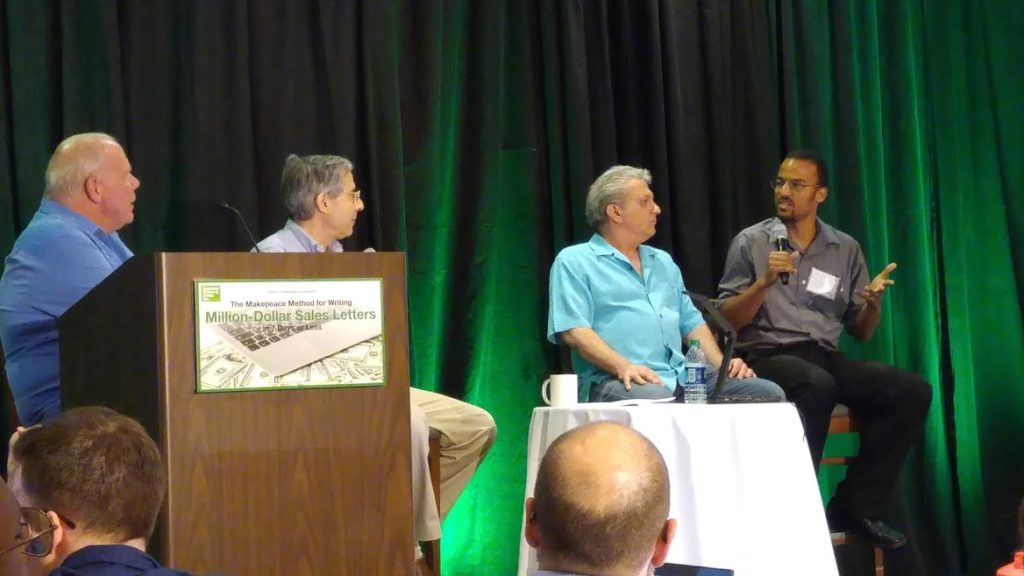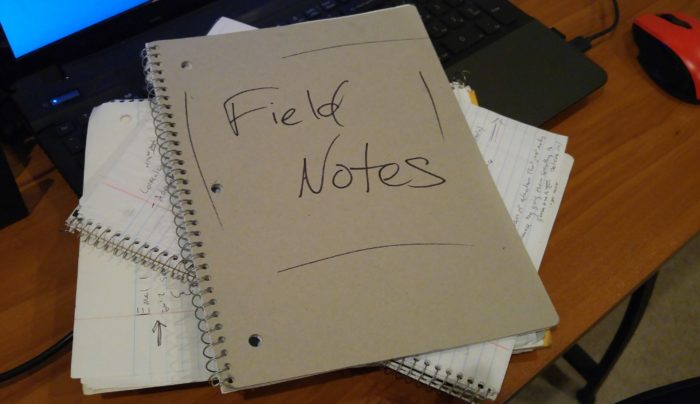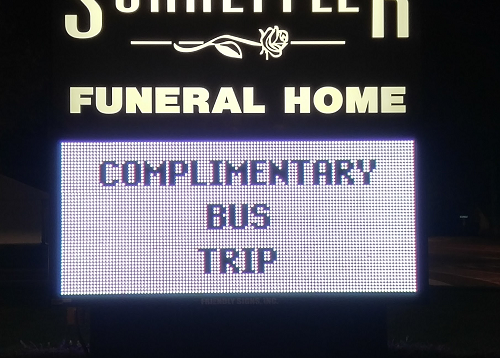We have a tendency to make copywriting (and persuasion in general) more complicated than it needs to be.
A lot of the blame can be placed on the countless “experts” who make it seem complicated…
I fear I’ve fallen into that category at times.
Today, we’re going to simplify things.
At it’s core, copywriting is helping someone make a decision that will improve his life in a specific way.
Humans make most of their decisions — not counting habitual “autopilot” programs we run for so many parts of our lives — based on emotion.
You already knew that.
One of the most effective ways to make another human feel emotion is to feel it yourself.
Emotions are contagious like a virus — and symptoms start showing up FAST.
When you sit down to write, start out by feeling the feeling you want you reader to experience.
Excitement…
Fear…
Hope…
Let those feelings bleed into your copy.
You already do this in face-to-face conversation — and even more so when it’s someone you care about.
Your emotions are transferred to the audience to some extent.
And when he’s feeling the way you feel, you have the opportunity to lead him where he needs to go to improve his life in the specific way only you can deliver.
Make sense?
Have a heart-to-heart conversation (through your copy) with your readers this week.
It will make all the difference in the world.
Copywriting Tips
Dave Chappelle’s Top 3 Copywriting Tips
As a copywriter or marketer, you should pay attention to great comedians.
They’re phenomenal communicators… creative thinkers who can expand your mind.
More importantly, they attract audiences and keep them spellbound — with little more than words.
This is a skill you can’t afford NOT to have in 2020 and beyond.
And no one does it better than your favorite comedian’s favorite comedian, Dave Chappelle.
Today I’m going to share 3 copywriting tips inspired by Chappelle’s most recent special, 8:46.
Really, I could talk about 7 or 8 helpful copy insights. There are so many gems.
If you haven’t already seen the video, you need to.
I encourage you to check it out before you continue reading the rest of this article.
It’s brilliant.
(I only wish I was as good a storyteller as Dave. It defies logic how good he is.)
I’m going to try to leave out any spoilers, just in case you decide to keep reading. I know how you are.
Alright, let’s dive in.
Copy Tip #1: Use open loops and callbacks.
At about the 2:10 mark, introduces a hot topic, then says he’s going to talk about it a little later.
This is a topic the audience KNOWS he’s can’t stay away from. Many of them are desperate to hear him address it.
But he teases it anyway. “I’ll talk about it in a minute.”
As a copywriter, open loops like these can help keep the reader/viewer strapped in and attentive.
You make him curious… then you make him wait for satisfaction.
When you do it right, he can’t close the email or stop the video until you close the loop.
And the impact of the payoff can be even stronger when you set it up this way. The anticipation and rising drama make it more satisfying when you finally reveal what you’ve been holding back.
Chappelle doesn’t wait long to close the loop in this case. You can play with the length of time you wait for your big reveal.
Copy Tip #2: Tight analogies and metaphors are persuasive uppercuts.
3:30 into the video, Dave tells a story about the first earthquake he experienced. He described the confusion and fear he felt.
Then, instead of evolving into a joke, he makes the story an analogy for the topic (in part) he teased in the beginning of the set.
The comparison adds a new perspective to the topic. A new way of looking at something you may feel you already understand.
Or maybe the analogy gives you a frame of reference to understand something you’ve never experienced.
In sales copy, you want to paint a picture that sucks the reader in. You pull them into your world by helping them mentally and emotionally experience SOMETHING related to the thing you’re selling.
Analogies and metaphors are effective ways to do that. These metaphors often take the shape of a personal story.
Your reader already has strong associations with and feelings about certain topics. You don’t necessarily have to create new associations, thoughts or feelings.
The right analogy can unleash the power of those associations and attach them to you or the product/service/idea you’re presenting.
At 10:40, Chappelle shares another analogy in the form of a story.
I can’t speak for anyone else, but I was totally transfixed for 3 minutes as he laid out the details. You don’t really know where he’s taking you, but you’re deeply invested in finding out.
(Again, this is a skill we MUST have in this new decade.)
When he finally ties the story back to the main topic… man. It’s an experience.
Different people will feel different ways about that analogy. One of those feelings is validation — and if you can make anyone feel like he’s been right all along, you’ve probably earned a friend for life.
So analogies are a very useful tool for persuasion.
Copy Tip #3: The copy isn’t about you, but you should weave yourself into the narrative.
My favorite thing about 8:46 is the way Chappelle weaves himself into this topic in various ways throughout the set.
It’s crazy.
Somehow, he links
- his birthday (24:28 into the video)
- his time of birth (at the 9:05 mark)
- his connection to Kobe Bryant (by some miracle 24 minutes in)
- a police officer that pulled him over (18:55)
- his father’s death (5:24)
- his great grandfather’s place in history (25:50)
… all into the topic he’s discussing.
It’s seamless and fascinating.
Here’s the big idea. Your sales copy isn’t supposed to be about you. It’s all about your should-be buyer.
But, the more you can smoothly tie yourself into the thing your buyer wants or needs… the more you can build up your authority in the area your buyer is interested in…
The more effective your copy can be. And the more likely you are to take ownership of real estate in your should-be buyers mind even if he doesn’t buy today.
Great copy is focused on the transformation your buyer desires to achieve.
The very best copy reveals that YOU (your product, service, idea) are inextricably linked to that transformation.
Keep that in mind next time you’re writing a sales piece.
Dave Chappelle isn’t a copywriter, but he can teach us all a thing or two about persuasive communication.
I encourage you to study him and other great comedians along with your favorite copy guru.
It’ll pay off in the long run.
Kobe Bryant’s Triangle Offense of Copy
The LA Lakers retired my pretend cousin’s jersey last night.
Actually, they retired two jerseys for the two numbers he wore while he played.
Here’s a little trivia for you.
In addition to Kobe’s legendary basketball career, did you know he’s also started and sold an advertising agency… directed many of the Nike commercials he starred in, and is now involved in all kinds of marketing activities for his own company and others?
Yep.
Kobe is likely to go down in history as a Hall of Fame athlete and ad man.
Earlier this year, he spilled the beans on his Triangle Offense of storytelling and copywriting. I’ll let him tell you in his own words:
—–
“The product and the messaging must be one and the same, right? It’s like a triangle approach I take with all storytelling…
1) What is the essence of the product? What is the product here to do? What is the messaging that we want to represent?
2) How can we best communicate that plainly and simply?
3) And thirdly, how do both of those things relate to human nature as a whole?
If those three things align, then I know we have the right messaging.”
—–
It’s hard to beat that simple formula.
Get down to the core, emotional benefits. Share those benefits with clarity as they related to human nature and psychology.
The only thing I would add here is that you can go beyond general human nature and address the specific nature, dreams and desires of your specific target audience.
Of course, Kobe knows that. He just didn’t say it in this interview.
Field Notes from My $6 Million Year
Over the past 12 months, I’ve written copy that’s generated over $6 million in sales (that I know of) for my clients. The weapon of choice has been email marketing.
That number is not meant to impress you, but to reassure you that what I’m about to share with you has been proven to work in the real world
I’m not sharing what I’ve heard about, but what I’ve experienced firsthand.
This could probably be a book, but I’ll keep it brief.
Here are a few of the most important lessons I learned, relearned or doubled down on this year:
1) Don’t assume you know your audience
Ask questions, do surveys, but most importantly, pay attention to the actions they take when interacting with your content.
- What kind of subject lines do they open?
- Where do they click?
- What length seems to work best?
- What kind of offers do they respond to?
- What totally bombs?
2) Test a lot of (wildly different) things
This ties to the previous idea. You can’t measure the relative effectiveness of one proposition against another unless they’re different enough to be unmistakable from each other. That’s especially true when you don’t have tens of thousands of people seeing and reacting to the message.
The best way to have a good idea is to have lots of ideas. You can still test a red button vs. a blue one, but that’s not where breakthroughs are going to happen.
One example from early this year was a ~300 word email pointing to a long sales page vs. a 1500 word email going to an order form. In this particular instance, the long email outperformed the short one by 5X. This one baffled the heck out of me!
On the other hand, some of the highest converting landing pages I’ve seen only have one sentence on them. Different ideas work on different offerings, even with the same audience. That’s why you have to keep testing!

3) Quality is better than quantity
Not every company agrees. Even some of the clients I’ve worked with don’t agree. You can treat list building as a pure “numbers game” and bring in the maximum number of people with vague or misleading squeeze pages and hope some of them will eventually become good customers or clients. I believe and have generally found that being “for” a specific audience, with specific promises and a distinct voice will bring in far smaller numbers of far superior readers/prospects.
4) The most important thing is the offer, or more specifically, your Audience-Offer Alignment
Strong copy can only do so much for you. Selling something people want is much more important — and easier than convince them to buy something that doesn’t obviously fit into their plans/priorities.
5) Your reader responds how you train him to respond — starting with how you acquired him
If you bring in subscribers with a fear-based offer or lead magnet, that sets the stage for what they’ll expect in the future. It may be difficult to pivot later. If you offer discounts at the end of every month, they won’t respond to offers early in the month. If you always extend your deadline, they won’t take them (or you) seriously.
Brian Kurtz wrote a great article exploring this point, with a Gary Bencivenga/Boardroom case study.
Clarity and consistency are necessary for building trust and setting appropriate expectations. Variety is critical for maintaining interest and curiosity.
6) People are getting smarter, so response is harder than ever to get
Many marketers are resorting to gimmicks to overcome our instant delete reflexes: bait and switch subject lines and body copy. Using “re:” and one-word subject lines to catch you off guard and get the click.
Those tactics do work — but they’re getting less effective every day because you can only fool someone so many times. Use such techniques sparingly. Rather, strive to be truly valuable, interesting and trustworthy to your readers.
In other words, don’t try to be slick. It’s a bad long-term plan — and it’s not great in the near-term, either.
7) Stories sell
You’ve heard it a thousand times, and it’s no less true now than it was the first time. Personal stories, historical anecdotes, even fun little facts get people reading, keep them interested and neutralize their resistance, at least temporarily.
I’ve seen the addition of a narrative element double clickthrough rates and triple conversion rates vs. straight product description or marketing talk.
8) Sequences, not single shots
Give yourself more shots by communicating in sequences rather than single blasts. And if you connect one email to the next, you can increase readership and compound the persuasive power of the campaign as a whole.
Just remember to test this. One of the most recent tests I did pitted a single email vs. two email, one-day offer — and the single email outpeformed by about 20%.
9) Urgency works like nothing else
Most people procrastinate as if their sanity depends on it. Deadlines move people to action. Open invitations are often ignored.
10) Customer Lifetime Value is the ultimate metric — not open rates or CTR
As Clayton Makepeace told me, if you’re making money on the front end, you’re doing it wrong!

This isn’t necessarily a set-in-cement rule. The point is to abstain from worrying so much about what it costs to acquire customers. Focus on getting as many of the right people on your files as possible. With the right back end, the cost per acquisition is a relatively small matter.
Many entrepreneurs and marketers are too focused on the front end costs. Clayton’s advice is an attempt to rearrange that thinking.
Miracles, by Definition (Copywriting Tip #9)
Quick Copywriting Tip #9: Better Products Make for Better Copy.
These days, when people ask for advice about how to “fix” their sales copy, the first question I usually ask is…
Does anyone actually want to buy this?
Sounds like a jerk question. Some people are offended when I ask it. I’m not trying to be a jerk. But this is THE question.
If people don’t already want the product or the result it produces, there isn’t much point in talking about the copy. There has to be at least a modicum of desire.
Example from my city (Bourbonnais, IL): How does a funeral home sell complimentary bus trips? What copy changes could make this appealing?
Last year, there was a client I really wanted to work with. At some point during our conversation, I told the president of the company “I can’t work miracles on demand. If that’s what you’re looking for, you’ve got the wrong guy.”
Miracles, by definition, cannot be produced on demand. There are a few copywriters who come close.
Good products — products targeted at specific needs — need fewer miracles. They make copy better almost by default.
If your product doesn’t meet the market where it’s at...if no one signs up for the complimentary funeral parlor bus trip… don’t automatically blame the copy.
Find out what people want and make that. Give your copywriter something to work with.
According to Gary Bencivenga, this is the 9-word secret so powerful that it has built more fortunes than any other principle in marketing: “A gifted product is mightier than a gifted pen.“
Have a productive day!
P.S. Any creative ideas about how to sell those bus trips??? 🙂
—
Check out all 13 Quick Copywriting Tips.
Bumper Sticker Revelations (Copywriting Tip #2)
Quick Copywriting Tip #2: Speak to just one person. Copy should be a one-on-one conversation.
Bumper stickers aren’t just clever jokes designed to entertain or infuriate other drivers. They are tiny (and sometimes not so tiny) glimpses into the car owner’s inner world.
A few square inches can reveal profound insights into who that person thinks about himself and his place in the world. You can learn something about the priorities, values and worldview of the person who stuck the sticker.
Here’s a fun, mind-expanding exercise you should try: pay attention to the bumper stickers you see. Try to deduce what the messages tell you about the drivers.
A simple example that comes immediately to mind is the “26.2” sticker.
In four characters (the coded language of an insider), that person identifies himself as a proud marathoner.
Now, here’s a clever spin-off on that theme: the “0.0” sticker. Makes me laugh every time.
These two parties see themselves differently and move through the world differently – in at least a couple areas. They probably respond differently to messages about exercise, diet, etc.
As a marketer, you have to figure out which bumper sticker your ideal customer has on his car.
There’s a big difference between distance runners and couch potatoes. Decide which one you’re going to serve and speak to him…in his language.
—
Check out all 13 Quick Copywriting Tips.




